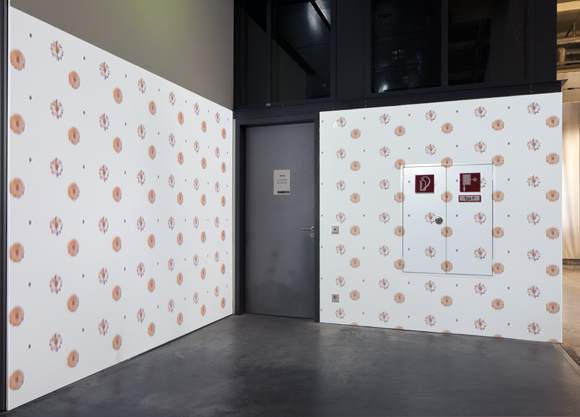|
Untitled (Video Wallpaper), 2003
Samuel Rousseau

Untitled (Video Wallpaper) is an immersive video installation by the French artist Samuel Rousseau. Since 2003, the artist has enlarged the installation’s repertoire, creating new versions. This case study comprises the four wall patterns found in the collection of FRAC Alsace. The “video wallpaper” consists of simple playful animations, multiply projected as a pattern on wall surfaces and thus becoming wallpaper made of moving light. For each installation, the artist sets up the projection in such a way as to precisely cover the area of the chosen wall surface, paying attention to any particular characteristics of the wall – furnishings or other objects which restrict or cover the surface. The animations only cover and animate the free wall surfaces. Colorful flowers overlap and blend into each other: toy cars turn in circles, Buddhas’ eyes roll their pupils. In this way, the artwork is playfully introduced into the room, animating it in unexpected ways.
Samuel Rousseau has worked with digital video since the 1990s and has always striven to break away from 4:3 format. He introduces his short clips into unexpected places, projecting animated fiction into spaces and onto immobile objects. In P’tit bonhomme (1996), a tiny projected figure tried in vain to climb a real staircase. By means of these humorous and subtle interventions, Rousseau addresses questions of social norms and the place of the individual in society.
Conservation measures
The installation of Untitled (Video Wallpaper) requires the video files with the wall patterns; these projected patterns must also be “trimmed” with a video editing program in order to fit the desired projection surface. FRAC Alsace are in possession of the video files (one DVD-R, Digital Versatile Disc-Recordable, for projection, and one DVD for viewing purposes), as well as information on the installation procedures. However, the collection does not have software or instructions for the adjustment of the projection to the projection area – therefore the artist has to attend every new installation of the work.
The raw material for the wallpaper patterns is four classical animations with various motifs, in Quick Time format (file ending: .mov), produced by Rousseau with the help of Adobe Photoshop and Final Cut Pro. The aspect ratio of the individual animations is 4:3. In the context of the research project the process of adapting the projection to the projection surface is to be recorded by the artist, thus making it possible in future to install the piece without him. This process requires several steps, which Rousseau undertakes using Adobe After Effects or Apple Motion and DVD Studio Pro. The appropriate means of documenting this process is to create a “screencast”, a recording of screen activity during the use of a software application, including mouse movement and clicks.
In the case of this artwork, a redundant data backup strategy (see the Glossary) for long-term safeguarding of the video files is highly desirable.
Photo: ONUK
|